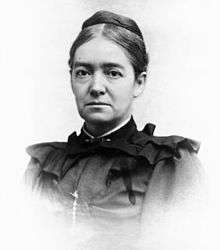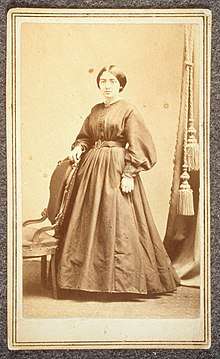Mary Corinna Putnam Jacobi
Mary Corinna Putnam Jacobi (August 31, 1842 – June 10, 1906) was an esteemed American medical physician, teacher, scientist, writer, and suffragist.[1] She was the first woman to study medicine at the University of Paris, and had a long career practicing medicine, teaching, writing, and advocating for women's rights, especially in medical education.[2] Disparaging anecdotal evidence and traditional approaches, she demanded rigorous scientific research on every question of the day. Her scientific rebuttal of the popular idea that menstruation made women unsuited to education was influential in the fight for women's educational opportunities.[2]
Mary Corinna Putnam Jacobi | |
|---|---|
 Mary Corinna Putnam Jacobi | |
| Born | Mary Corinna Putnam August 31, 1842 London, UK |
| Died | June 10, 1906 (aged 63) |
| Nationality | American |
| Education | Female (later Women's) Medical College of Pennsylvania Faculté de Médecine de Paris |
| Known for | Medicine |
| Spouse(s) | Abraham Jacobi (m. 1873) |
| Children | Marjorie Jacobi McAneny |
| Parent(s) | George Palmer Putnam and Victorine Haven |
| Family | (brothers) George Haven Putnam, John Bishop Putnam, Herbert Putnam |
Early life
Mary Corinna Putnam was born on August 31, 1842 in London, England. She was the daughter of American parents, George Palmer Putnam and Victorine Haven Putnam, originally from New York City. Mary was the oldest of eleven children.[3] At the time of Mary's birth, the family was in London because her father George was establishing a branch office for his New York City publishing company, Wiley & Putnam.[3][4]
In 1848, at the age of six, Mary's family moved from London back to New York, where she spent the rest of her childhood and adolescence.[5] Mary was educated at home by her mother Victorine for most of her early years before she attended a private school in Yonkers. Later she attended a public school for girls on 12th Street in Manhattan where she graduated in 1859. After graduating, she studied Greek, science, and medicine privately with Elizabeth Blackwell and others.
As a teenager, Mary dabbled in writing, publishing short stories in The Atlantic Monthly from the age of fifteen, and later in the New York Evening Post.[2]
Adult life and career

Although Mary's father George Putnam believed a career in medicine was a "repulsive pursuit," he reluctantly agreed to financially support Mary's decision to pursue medicine, an ambition she had held since childhood.[2] In 1863, Jacobi graduated from the New York College of Pharmacy, which made her the first woman to graduate from a United States school of pharmacy.[6][5] In 1864 she received her M.D. from the Female (later Women's) Medical College of Pennsylvania. For several months, she then practiced clinical medicine with Marie Zakrewska and Lucy Sewall at the New England Hospital for Women and Children.[7] She also served in the Civil War as a medical aide.[8]
During a short internship in which she studied clinical medicine at the New England Hospital for Women and Children, Mary decided to further her study of medicine and apply to École de Médecine of the University of Paris.[4] After much negotiation and thanks to the help of the psychiatrist Benjamin Ball, in 1868 she was admitted as the first woman student at École de Médecine, although as a woman she was required to enter lectures through a separate door and sit at the front near the professor.[2] In July 1871 Jacobi graduated with honors and was the second woman to receive a degree from École de Médecine of the University of Paris. Jacobi also received a bronze medal for her thesis. Her studies in Paris coincided with the Franco-Prussian War. In Scribner's Monthly of August 1871, she published an account of the new French political leadership that came to power following the war.
After five years of studying in Paris, Jacobi returned to the United States in the fall of 1871. Moving back to New York City, Jacobi established her own private medical practice. Jacobi also participated in research and became a professor in the new Women's Medical College of the New York Infirmary and Mount Sinai Hospital.[4] Jacobi became the second woman member of the Medical Society of the County of New York, was admitted to the American Medical Association. In 1872 she helped to found the Women's Medical Association of New York City,[2] and served as its president from 1874 to 1903. She campaigned consistently for leading medical schools, like Johns Hopkins, to admit women students.[8] Her teaching at the Medical College tended to exceed what her students were prepared for and led her to resign in 1888. Dr. Jacobi was highly revered during her lifetime as the most accomplished woman physician.
In 1873, she married Abraham Jacobi, a New York physician and researcher, nowadays often referred to as the "father of American pediatrics." They had three children, two daughters, and one son. Mary and Abraham's first daughter died at birth and their only son died at the age of seven. Abraham and Mary had only one child who survived to adulthood, their daughter Marjorie Jacobi McAneny. Jacobi educated her daughter herself according to her own educational theories.
She received Harvard University's Boylston Prize in 1876 for an original essay, The Question of Rest for Women during Menstruation.[2] Jacobi's paper was a response to Dr. Edward H. Clarke's earlier publication, Sex in Education; or, A Fair Chance for the Girls (1875), a book claiming that any physical or mental exertion during menstruation could lead to women becoming infertile.[4] Jacobi did not believe this was the case, and to test the idea she collected extensive physiological data on women throughout their menstrual cycle, including muscle strength tests before and after menstruation. She concluded that "there is nothing in the nature of mentruation to imply the necessity, or even desirability, of rest."[2]
Jacobi wrote over 120 medical articles and nine books,[4] although she stopped writing fiction in 1871. In 1891 she contributed a paper on the history of women physicians in the United States to the volume Women's Work in America that included a bibliography of writings by American female physicians mentioning over forty of her own works. In 1894, she wrote Common Sense Applied to Women's Suffrage which was later reprinted and used to support the women's suffrage movement in the United States.[8] Also in 1894, after the defeat of the women's suffrage amendment to the New York State Constitution, Jacobi was one of six prominent suffragists who founded the League for Political Education.
While Elizabeth Blackwell (1821–1910) viewed medicine as a means for social and moral reform, the younger Jacobi focused on curing disease. Blackwell believed that women would succeed in medicine because of their humane feminine values, but Jacobi thought women's contribution to all medical specialties should be considered equivalent to men's.[7]
When she was diagnosed with a brain tumor, she meticulously documented her own symptoms and published a paper on the subject titled Descriptions of the Early Symptoms of the Meningeal Tumor Compressing the Cerebellum. From Which the Writer Died. Written by Herself.[2] She died in New York City on June 10, 1906.[3] Jacobi is interred at Green-Wood Cemetery in Brooklyn, New York.
She was inducted into the National Women's Hall of Fame in 1993.[9]
Selected works
- De la graisse neutre et des acides gras (Paris thesis, 1871)
- The Question of Rest for Women during Menstruation (1876)
- Acute Fatty Degeneration of New Born (1878)
- The Value of Life (New York, 1879)
- Cold Pack and Anæmia (1880)
- The Prophylaxis of Insanity (1881)
- "Some Considerations on the Moral and on the Non Asylum Treatment of Insanity". In: Putnam Jacobi, Harris, Cleaves, et al. The Prevention of Insanity and the Early and Proper Treatment of the Insane (1882)
- "Studies in Endometritis" in the American Journal of Obstetrics (1885)
- Articles on "Infantile Paralysis" and "Pseudo-Muscular Hypertrophy" in Pepper's Archives of Medicine (1888)
- Hysteria, and other Essays (1888)
- Physiological Notes on Primary Education and the Study of Language (1889)
- "Common Sense" Applied to Women's Suffrage (1894) This expanded on an address she made that same year before a constitutional convention in Albany. It was reprinted in 1915 and contributed to the final successful push for women's suffrage.
- Found and Lost (1894)
- From Massachusetts to Turkey (1896)
- Description of the Early Symptoms of the Meningeal Tumor Compressing the Cerebellum. From Which the Writer Died. Written by Herself. (1906)
References
- Denise Grady (November 11, 2013). "Honoring Female Pioneers in Science". New York Times. Retrieved December 14, 2014.
Mary Corinna Putnam Jacobi, born in 1842 in London, grew up in New York and began publishing short stories at 17. But what she really wanted was to be a doctor. ...
- Swaby, Rachel (2015). Headstrong: 52 Women Who Changed Science- and the World. Broadway Books. pp. 3–6. ISBN 9780553446791.
- "Dr. Mary Putnam Jacobi". Retrieved November 17, 2012.
- "Open Collections Program: Women Working, Mary Putnam Jacobi (1842–1906)". ocp.hul.harvard.edu. Retrieved April 25, 2018.
- "Jacobi, Mary Putnam, 1842-1906. Papers of Mary Putnam Jacobi, 1851-1974: A Finding Aid". oasis.lib.harvard.edu. Archived from the original on April 25, 2018. Retrieved April 25, 2018.
- "Happy Mother's Day to Women Pioneers in Pharmacy". Digital Pharmacist. May 10, 2018. Retrieved December 31, 2018.
- Regina Markell Morantz, "Feminism, Professionalism and Germs: The Thought of Mary Putnam Jacobi and Elizabeth Blackwell," American Quarterly (1982) 34:461-478. in JSTOR
- Bowman, John, ed. (2001). "Mary Corinna Putnam Jacobi (1842-1906)". Cambridge Dictionary of American Biography. Ipswich, Massachusetts: Literary Reference Center. ISBN 9780521402583.
- National Women's Hall of Fame, Mary Putnam Jacobi
Further reading
- Bittel, Carla. Mary Putnam Jacobi and the Politics of Medicine in Nineteenth-Century America (2009) excerpt and text search
- Bittel, Carla Jean (2005). "Science, suffrage, and experimentation: Mary Putnam Jacobi and the controversy over vivisection in late nineteenth-century America". Bulletin of the History of Medicine. 79 (4): 664–94. doi:10.1353/bhm.2005.0138. PMID 16327083.
- Gartner, C B (May 1996). "Fussell's folly: academic standards and the case of Mary Putnam Jacobi". Academic Medicine. 71 (5): 470–7. doi:10.1097/00001888-199605000-00016. PMID 9125974.
- Harvey, J (1994). "La Visite: Mary Putnam Jacobi and the Paris Medical Clinics". Clio medica (Amsterdam, Netherlands). 25: 350–71. PMID 7517812.
- Ross, M M (1992). "Women's struggles to enter medicine: two nineteenth-century women physicians in America". The Pharos of Alpha Omega Alpha-Honor Medical Society. Alpha Omega Alpha. 55 (1): 33–6. PMID 1565681.
- Farley, F (1984). "Two generations of women physicians: the New York Infirmary, 1870–1899". Journal of the American Medical Women's Association. 39 (6): 189–91. PMID 6392396.
- Davis, P J (November 1965). "Mary Putnam Jacobi". New England Journal of Medicine. 273 (19): 1037–1038. doi:10.1056/nejm196511042731909. PMID 5320889.
- Wilson, J. G.; Fiske, J., eds. (1892). . Appletons' Cyclopædia of American Biography. New York: D. Appleton.
- Rines, George Edwin, ed. (1920). . Encyclopedia Americana.
- Gilman, D. C.; Peck, H. T.; Colby, F. M., eds. (1905). . New International Encyclopedia (1st ed.). New York: Dodd, Mead.
- Mary Bronson Hartt (1932). "Jacobi, Mary Corinna Putnam". Dictionary of American Biography. New York: Charles Scribner's Sons.
- Carol B. Gartner (1999). "Jacobi, Mary Corinna Putnam". American National Biography (online ed.). New York: Oxford University Press. doi:10.1093/anb/9780198606697.article.1200449. (subscription required)
External links
| Wikimedia Commons has media related to Mary Corinna Putnam Jacobi. |
- Mary Putnam Jacobi Papers. Schlesinger Library, Radcliffe Institute, Harvard University.
- Putnam, Mary-C. (1871). 'La graisse neutre et des acides gras.' Thesis pour le Doctorat en Médecine, Faculté de Médecine de Paris. Digitized from the New York Academy of Medicine Collection of International Medical Theses, 1801-1981. Health Sciences Library. University of North Carolina at Chapel Hill.
- Changing the Face of Medicine: Celebrating America's Women Physicians - Dr. Mary Corinna Putnam Jacobi. A project of the United States National Library of Medicine, National Institutes of Health.